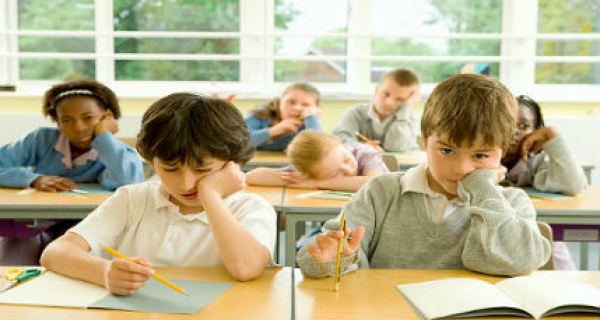SET THE SPACE
Do you walk into a room and automatically switch on the lights? Most overhead lighting—especially fluorescent lighting—is too bright for young students’ needs. Maximize natural lighting, and match lighting to the needs of an activity. For example, a literacy centre may require the direct beam of a lamp, while a dramatic play space could use some magical, soft string lights.
Choose colours that evoke positive, soothing feelings. Keep displays and decorations at the children’s eye level. Leave some blank space for children’s artwork displays and other blank space where little eyes can simply rest.
When possible, plants can improve the classroom as well as balance humidity levels. Having live plants offers the added benefit of giving children the opportunity to learn responsibility as they help care for plants. Attention to the overall feeling of the physical space can help create a calm learning environment.
BE INTENTIONAL WITH COMMUNICATION
Facing children at their eye level by squatting, sitting, or kneeling allows for eye contact but also lets you see the world from their perspective. Eye contact with a child helps a teacher detect their energy intensity level and intervene with nonverbal cues. Communicating at eye level also allows a teacher to convey peace and security.
A 3-year-old boy in our class was having difficulty separating from his dad at drop-off time. I got down on the floor to his eye level and looked into his eyes. I smiled and used a soft voice to explain that Daddy would be back soon, but now it was time to play at school. I waited, taking a deep breath, as he looked into my eyes and slowly calmed. I took his hand and offered him two choices of play locations. Using eye contact helped connect with him and return him to a calmer state.
Cultivate a tranquil tone in your classroom. Maintaining a softer tone model the appropriate volume level for students. For some children, soft music playing in the background can help regulate intonation.
Sometimes the transition times between activities can be chaotic, as children tend to be excited and loud. Speaking softly about a physical object that the children find interesting or fun can make the transition calmer. Singing a quiet song about the process, such as “Come, come, come to circle” or "Eyes are watching, ears are listening, voices quiet, body calm,” can provide a unified way for students to participate in the transition. Gradually, the children calm to sit quietly and listen as the circle time routine begins.
Teach students how to have a conversation by modelling. Consistently ask children to walk over to people with whom they want to communicate. Model how to gently get attention by saying, “Excuse me,” or resting a gentle hand on a shoulder.
EMBRACE ROUTINES
Establish routines to help preschoolers move smoothly through the daily schedule. Explain the routine to the children, and directly teach the sequence of steps in any routine before it is time to participate in it.
Preparing students in advance allows them to better engage in the transition and the new activity. Because young children need to know what is coming next, it is important to attend to the transitions between activities. Give clear forewarnings for all transitions using words, visuals, or tactile cues. Dimming the lights or ringing a small bell can cue the children to stop, look, and listen. Reinforce the direction by coupling it with physical activity such as asking students to raise their hands, point to their eyes, and cup their ears. Verbal warnings can signal an upcoming transition so that students can prepare. A simple direction such as, “We have five more minutes to play. Then it’s clean up time,” can be paired with visual/tactile cue, such as high five to each child.
Visual aids, like puppets, help children understand a concept without the emotional confusion that may arise when an adult gives a directive. Use animal puppets related to the curricular theme to reinforce learning, or identify special puppets who demonstrate specific skills or strategies. For example, to establish a new routine such as waiting in line to wash hands, two puppets might discuss why it is important to wash hands before eating. The puppets can also demonstrate the behaviour that students should avoid. For example, the puppets waiting in line might push or shove to get to the sink. Follow the puppet demonstration with a conversation about their behaviour.
Imaginative interaction such as modelling, role-playing, or sharing stories can help children internalize new routines. For example, children can act out what it is like to have a calm body and what it is like not to have a calm body while waiting.
Consistent routines help foster learning by eliminating distractions and keeping students in sync with their activities and each other.
By Elaine Heiskell








